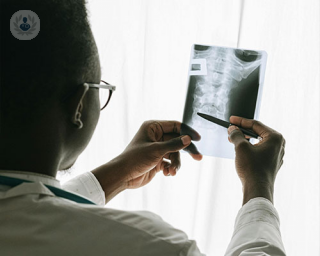Robotic spine surgery
Mr Ramsey Chammaa - Orthopaedic surgery
Created on: 11-13-2012
Updated on: 01-05-2024
Edited by: Karolyn Judge
What is robotic spine surgery?
Robotic spine surgery, or more accurately, robot-guided spine surgery, is a type of surgery which uses robotic systems and technology as an aid in the surgical procedure. It uses smart, autonomous instruments which can be operated remotely by the surgeon, and allow for increased precision and smaller incisions.

Why is it done?
Robot-guided or robot-assisted surgical techniques such as robotic spine surgery allow the surgeon to have better control over the instruments which they are using. These techniques are minimally-invasive and allow for smaller incisions, reduced scarring, reduced post-operative pain, and faster recovery.
Traditional open spinal surgery
Traditional open surgery, particularly in spinal surgery, is invasive and traditionally performed with large incisions. Robotic spine surgery may provide better outcomes for the patient, but few trials have been performed and robotic techniques are not used as often as in other specialties, for example urology.
What conditions are treated with robotic spine surgery?
Robotic spine surgery can be used to treat many types of spinal condition or injury, including:
- Spinal tumours
- Spinal fractures
- Degenerative disc disease
- Spinal deformity
Implants and fusion procedures can also be performed using robotic techniques.
What does it involve?
In robotic spine surgery, the surgeon guides special instruments through computer control or through a remote manipulator, which is a device that allows the surgeon to control the instruments remotely. The instruments used are incredibly precise, reducing tissue trauma or eliminating it entirely. Robot-guided surgery also allows for a better view of the area being operated on. The surgeon can also sit during the procedure, meaning they do not tire as quickly using these techniques.
How do you prepare for robotic spine surgery?
Prior to robotic spine surgery, your surgeon will provide you with instructions so you will know what to expect before and after the procedure. You may need to have tests performed beforehand, such as blood tests, urine tests, CT scans, or ultrasound, which help your doctor to understand if you are suitable for surgery and you are in optimal condition.
Before surgery you will also be advised which medications you need to stop taking, such as blood-thinners (e.g ibuprofen).

What aftercare is involved after robotic spine surgery?
As robot spine surgery is minimally invasive, you shouldn't need to stay in the hospital for a long period. You may even only need an overnight stay before being discharged. Your surgeon will advise you on what to expect after the procedure.
After surgery, you may feel sore and you will be able to take pain medication to help you feel more comfortable. This pain and soreness will get better over the next few days or weeks.
Your surgeon will advise you on cleaning and aftercare for your specific wounds, and when you will be able to shower again. To aid in the healing process, you should avoid strenuous activity and return to work/driving when advised by your doctor.










